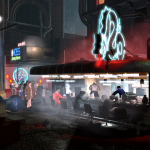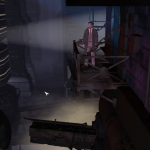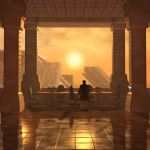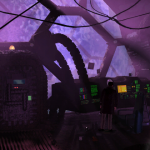 Blade Runner was released in 1997 by Las Vegas based developer Westwood Studios who at this point is mainly known for pioneering the real-time strategy genre with its Command & Conquer series before being dismantled by EA. The game is a fairly classical point & click adventure game based on the 1982 movie of the same name. Despite sharing the same setting and timeframe as the events depicted in the movie, the game tells a completely new story with some of the characters from the movie making appearances.
Blade Runner was released in 1997 by Las Vegas based developer Westwood Studios who at this point is mainly known for pioneering the real-time strategy genre with its Command & Conquer series before being dismantled by EA. The game is a fairly classical point & click adventure game based on the 1982 movie of the same name. Despite sharing the same setting and timeframe as the events depicted in the movie, the game tells a completely new story with some of the characters from the movie making appearances.
The game’s protagonist, Ray McCoy is a Blade Runner – a cop in charge of finding and capturing, artificial beings. These “Replicants” were originally created as cheap labor forces by the Tyrell Corporation, but have a tendency to run off in their desperate struggle to extend their predetermined life span of four years. While the setting of the movie is used heavily, the game’s plot also draws more directly upon Phillip K. Dick’s story “Do Androids dream of Electric Sheep?” which was the source material for the movie.
 Most of the game revolves around visiting various crime scenes, talking to witnesses, and finding evidence. Starting off with two or three seemingly unrelated cases, the player soon finds himself as part of a classic noir plot as the game progresses. What makes the game unique is that there is a certain element of randomness to every play-through: each major character in the game can either be human, or a Replicant. This includes the game’s protagonist, and ultimately the player has to make the decision to either hunt down the replicants, or to side with them.
Most of the game revolves around visiting various crime scenes, talking to witnesses, and finding evidence. Starting off with two or three seemingly unrelated cases, the player soon finds himself as part of a classic noir plot as the game progresses. What makes the game unique is that there is a certain element of randomness to every play-through: each major character in the game can either be human, or a Replicant. This includes the game’s protagonist, and ultimately the player has to make the decision to either hunt down the replicants, or to side with them.
The player controls McCoy by navigating the visually striking pre-rendered animated screens. The engine highlights areas of interest, as well as characters to interact with. Despite being released over a decade ago, the game still looks good on modern computers: the animated backgrounds featuring constant rain, reflections, and flying cars zipping by greatly contribute to the game’s atmosphere and paint a vivid picture of the future noir. Even though it’s hard to see on static screenshots, especially the animated light effects are quite striking. The only downside is the character animation, which in contrast looks pretty blocky and lacks detail.
 Unlike many other games in the genre, the dialogs in Blade Runner do not branch out a lot, and there is usually just one conversation option for each character. However, the player does have control over the tone of the conversation, by selecting if McCoy should act polite, normal, surly, or even erratic. The game is fully voiced, and luckily the producers were able to get the actors from the movie to reprise their roles for this part. I did find some of the dialogs to be rather expansive, requiring the player to just sit and listen for three or four minutes at a time, without any interaction.
Unlike many other games in the genre, the dialogs in Blade Runner do not branch out a lot, and there is usually just one conversation option for each character. However, the player does have control over the tone of the conversation, by selecting if McCoy should act polite, normal, surly, or even erratic. The game is fully voiced, and luckily the producers were able to get the actors from the movie to reprise their roles for this part. I did find some of the dialogs to be rather expansive, requiring the player to just sit and listen for three or four minutes at a time, without any interaction.
For those familiar with the movie, it will be of interest that Westwood managed to include some of the computer systems that were depicted in the movie: there are multiple occasions where the player has the option to perform a so called “Voight-Kampff” test on those he suspects to be replications. Also, the image magnification system can be used to get additional clues from each crime scene. Both of these aspects of the game are well implemented and stand out uniquely among the more conventional puzzles mechanics of the game.
 The game does not feature the original soundtrack from the movie, but provides a rather fitting new score as a substitute. Overall, the adaptive music system left a good impression, especially by creating tension and a sense of danger whenever a critical situation arose during the game: this happens more often than in other games of the genre, as the player can die at numerous occasions. Oftentimes, this is not so much a matter of the player making a wrong choice, but more so of a number of clumsy action sequences which require precise timing. In the end, these are annoying, but there aren’t enough of them to negatively affect the overall impression.
The game does not feature the original soundtrack from the movie, but provides a rather fitting new score as a substitute. Overall, the adaptive music system left a good impression, especially by creating tension and a sense of danger whenever a critical situation arose during the game: this happens more often than in other games of the genre, as the player can die at numerous occasions. Oftentimes, this is not so much a matter of the player making a wrong choice, but more so of a number of clumsy action sequences which require precise timing. In the end, these are annoying, but there aren’t enough of them to negatively affect the overall impression.
During my first play through for this review, I did feel a certain lack of direction at times. It is quite easy to miss items when visiting the many locations of the game, because the plot will progress with or without them. This is intentional though, and the player will still be able to finish the game. It is even possibly to kill, or to stay in the euphemistic language of the game, “retire” virtually all of the main characters – with varying consequences depending on whether or not they turn out to be human or Replicant.
 Given this premise, the game has about a dozen different endings: the player has to make choices about each character that truly have an effect on the outcome of the game. During the latter part, McCoy gets framed in a conspiracy plot which makes it impossible to know which characters to trust. All of this mirrors the movie’s ambiguity about the nature of humanity our definition of life, and makes the game a memorable experience. Combined with the great replay value, I would rate the game as an outstanding example of the graphic adventure genre, and a must-play for fans of the movie.
Given this premise, the game has about a dozen different endings: the player has to make choices about each character that truly have an effect on the outcome of the game. During the latter part, McCoy gets framed in a conspiracy plot which makes it impossible to know which characters to trust. All of this mirrors the movie’s ambiguity about the nature of humanity our definition of life, and makes the game a memorable experience. Combined with the great replay value, I would rate the game as an outstanding example of the graphic adventure genre, and a must-play for fans of the movie.
1 throught on "How do you know you’re not a Replicant?"